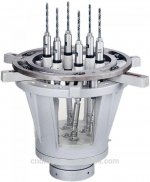alphonso
Titanium
- Joined
- Feb 15, 2006
- Location
- Republic of Texas
Tougher stuff than chemistry/heat treat suggest.
.515"(or .531) clearance holes, 2 7/8" thru.
We have tried a number of different combinations and multiple variations and can't seem to find a decent balance between tool life and cycle time.
Current set up is Precision Twist Drill, cobalt bronze oxide finish drills. 40sfm, .008 feed, .5 peck depth, flood coolant( TSC is out of action at the moment). Stub drill as deep as it can go then jobber to finish. 8 holes per part, 84 parts(672 holes), cycle time is 18 minutes. Get about 6 parts before drills get dull. Seems to be about the best life/time balance so far.
Tried a Chicago-Latrobe AlTiN cobalt drill with same parameters and the cutting edge started chipping after 12 holes.
Tried some carbide awhile back and it did cut a lot of time out but it didn't cut any more holes before it dulled.
Years ago, when the TSC was working, we tried a spade drill which worked until it had a catastrophic failure. Don't want to repeat that.
Should be able to get TSC back in service soon. Rotary union was leaking and ate up $1200.00 worth of bearings in less than a week. New union is slightly different design and I'm not sure exactly how it is supposed to work. Need to call manufacturer and find out.
Suggestions, recommendations, WAGs?
.515"(or .531) clearance holes, 2 7/8" thru.
We have tried a number of different combinations and multiple variations and can't seem to find a decent balance between tool life and cycle time.
Current set up is Precision Twist Drill, cobalt bronze oxide finish drills. 40sfm, .008 feed, .5 peck depth, flood coolant( TSC is out of action at the moment). Stub drill as deep as it can go then jobber to finish. 8 holes per part, 84 parts(672 holes), cycle time is 18 minutes. Get about 6 parts before drills get dull. Seems to be about the best life/time balance so far.
Tried a Chicago-Latrobe AlTiN cobalt drill with same parameters and the cutting edge started chipping after 12 holes.
Tried some carbide awhile back and it did cut a lot of time out but it didn't cut any more holes before it dulled.
Years ago, when the TSC was working, we tried a spade drill which worked until it had a catastrophic failure. Don't want to repeat that.
Should be able to get TSC back in service soon. Rotary union was leaking and ate up $1200.00 worth of bearings in less than a week. New union is slightly different design and I'm not sure exactly how it is supposed to work. Need to call manufacturer and find out.
Suggestions, recommendations, WAGs?




 ) part in the vise wrong way up.... The drill sure was pretty impressive till I landed up with half of the body in the chip conveyor.
) part in the vise wrong way up.... The drill sure was pretty impressive till I landed up with half of the body in the chip conveyor.
